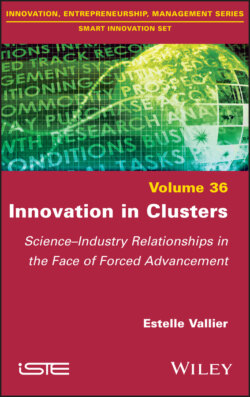Читать книгу Innovation in Clusters - Estelle Vallier - Страница 13
I.2.1. The advent of structures for science and industry intermediation
ОглавлениеThe literature uses the term “hybrid organization” (Branciard 2009) or “hybrid organism” (Leydesdorff and Etzkowitz 2000)14. Very quickly, within institutional vocabulary, the term “incubator” has become a cornerstone of science–industry rapprochement policies (Shinn 2002, p. 28). Nevertheless, among these different terms and, in a sociological approach, that of “public intermediation structure”, Brunet pertinently evokes the intervention of these structures between (“inter”) two quite distinct worlds (Brunet 2011), in order to facilitate arbitration intended to reconcile them (“mediation”)15. Moreover, this name highlights the public character of these institutions.
These structures, which are generally financed by local and national governments, can be found in various forms (associations, mixed syndicates, mixed economy companies, etc.). Most were created in response to calls for projects from competitiveness clusters. However, some were created before, and in parallel with, these clusters. The latter are anchored in a regional framework, but there are other structures for which territoriality is defined on a conurbation or a department scale. Most operate with an accreditation policy to attract laboratories and companies. Once accreditation is obtained, the new member organization benefits from services offered by the cluster (preferential rents, access to specialized and shared equipment, a computer network, etc.). When local geographic clustering is carried out, most structures rely on the “total network” (Suire and Vicente 2014). The relational density between the three actors of science, industry and training, enabled by geographical proximity, is touted as a major condition for innovation. Nevertheless, many intermediation structures struggle to meet this objective and find themselves confronted with the following organizational difficulty: how to create cooperation when it does not occur spontaneously through geographical proximity. This question echoes sociological literature, which highlights the absence of spontaneous links between spatial proximity and social interaction, notably in the study of the politics of large urban areas (Chamboredon and Lemaire 1970). Work on clusters also emphasizes the relationship or otherwise between, for instance, geographic, organized and cognitive proximity (Talbot and Kirat 2005; Bouba-Olga and Grossetti 2010; Torre and Zuindeau 2012).
This was the problem encountered by Genopole, a life sciences biocluster located in Evry, in the Essonne region of France, the main field of investigation for this book, which is the result of a thesis in sociology funded by Industrial Agreements for Training through Research (Convention industrielle de formation par la recherche, CIFRE) and which reports on the results of an immersion survey conducted over three and a half years, between November 2013 and April 2017. Genopole is a cluster that has already been studied in the literature, particularly on the political, economic and social conditions of its creation and institutionalization, mainly in the work of Anne Branciard (1999a, 1999b, 2002, 2004, 2009), as well as of Ashveen Peerbaye, which sheds light on the instrumental arrangements put in place by the cluster (Peerbaye 2004). Genopole has also been the subject of a comparative analysis of the transformation of science into technoscience, based on the cases of Evry, Laval (Quebec) and San Diego (California) (Heil 2010). There is only one other study that deals with its interactional dimension in a comparative approach. The article in question focuses on the “social capital of entrepreneurs as an index of cluster emergence” in a “comparative analysis of the transformation of two bioparks into bioclusters: Kobe (Kansai, Japan) and Evry (Paris region, France)” (Lanciano-Morandat et al. 2009). In their conclusion, the authors state that, although they have their own national characteristics, neither the Kobe nor the Evry bioparks can be categorized as innovation clusters as defined in literature insofar as:
They are still only aggregates of diverse entities with episodic relationships between them; in short, partial clusters […]. Both parks are struggling to integrate the entire innovation process, which, as Porter suggests, is a condition for their constitution as clusters. In addition, both parks have the weight of the state in their constitutions in common, the role of certain institutions in their creation, and their location on sites that have neither a tradition nor particular resources in terms of innovation (Lanciano-Morandat et al. 2009, p. 200).
In addition to the fact that the authors rely on the definition proposed by Porter to identify, or not, the clustering process, the idea of transformation from biopark (geographical grouping) to biocluster (interactions) is also strongly present in management literature (Hamdouch 2007). These concerns are also at the heart of current biocluster issues. Indeed, considerable space is given to this subject in formal and informal discussions within the cluster, warning about the difficulties of mobilizing companies and laboratories for joint meetings.
